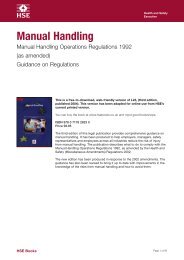Making Companies Safe - what works? (CCA ... - Unite the Union
Making Companies Safe - what works? (CCA ... - Unite the Union
Making Companies Safe - what works? (CCA ... - Unite the Union
You also want an ePaper? Increase the reach of your titles
YUMPU automatically turns print PDFs into web optimized ePapers that Google loves.
In contrast to this, two recent surveys indicate that reputational risk may be a driver for large<br />
firms. A 1999 MORI survey of 102 of <strong>the</strong> most senior directors in Britain, drawn from a<br />
representative sample of large companies, found that 79% of respondents cited health and<br />
safety as having a great or fair amount of tangible impact upon corporate reputation. 26 And<br />
Wright et al. report that amongst large organisations, concern about corporate responsibility<br />
and ethical image was <strong>the</strong> second top ranked influence determining board level involvement<br />
in health and safety management. 27<br />
There is no clear explanation for <strong>the</strong>se contradictory findings. Gunningham notes that much<br />
of Wright’s evidence that concern for corporate credibility is one of <strong>the</strong> main drivers of<br />
management commitment to OHS is drawn from studies of firms operating in high risk<br />
sectors, such as chemical production and public transport. In such sectors, firms fear “that <strong>the</strong><br />
adverse publicity, loss of confidence and regulatory attention subsequent to a serious incident<br />
will cause serious curtailment of operations, imposition of additional costs, loss of corporate<br />
credibility and loss of business/interruption of operations.” 28 Gunningham argues that:<br />
“Corporate image may be less influential in sectors which do not have such concerns.” 29<br />
Thus, <strong>the</strong>re appears to be some evidence that high profile firms in high risk sectors are most<br />
likely to be ‘reputationally sensitive’. However, Wright has identified a range of circumstances<br />
that will diminish concern for corporate image even amongst high risk, high profile<br />
operators. These will be discussed fur<strong>the</strong>r below. What is clear is that ‘reputational risk’ is<br />
highly contingent and will not motivate all organisations in all sectors all of <strong>the</strong> time.<br />
To <strong>what</strong> extent <strong>the</strong>n, and under <strong>what</strong> circumstances, might regulators be able to persuade<br />
employers that poor health and safety performance will damage <strong>the</strong>ir company’s reputation<br />
and that this will pose a significant risk to <strong>the</strong>ir business? These questions will be explored<br />
below.<br />
How does OHS performance impact upon corporate reputation?<br />
Research by Smallman and John suggests that <strong>the</strong> ‘poor OHS performance can lead to<br />
competitive disadvantage through impairing a firm’s status in <strong>the</strong> eyes of one or more of<br />
its stakeholders’, 30 but that good OHS performance does not generally enhance firm<br />
reputation or lead to competitive advantage. Thus, it appears that OHS performance<br />
generally only impacts on corporate reputation in a negative sense. This is consistent with<br />
Wright’s interpretation of <strong>the</strong> data. Wright suggests that:<br />
“<strong>the</strong> ultimate fear concerning adverse publicity and loss of public / customer<br />
confidence is that business activities may be curtailed”. 31<br />
A number of implications flow from this. First, <strong>the</strong>se findings suggest that, at present,<br />
concern for corporate reputation is unlikely to lead to improvements that go significantly<br />
beyond <strong>what</strong> is required by law. Second, a number of conditions must exist before<br />
reputational risk will begin to operate as a driver of OHS compliance:<br />
• <strong>the</strong>re must be a high chance that poor performance will be detected and broadcast;<br />
• <strong>the</strong>re must be an audience that will react to poor OHS performance,<br />
• and finally <strong>the</strong>re must be a significant chance that this audience reaction will result in<br />
<strong>the</strong> curtailment or interruption of business activity or some financial loss.<br />
The circumstances and extent to which <strong>the</strong>se conditions may exist are explored fur<strong>the</strong>r below.<br />
Detection and Blame<br />
In <strong>the</strong> UK <strong>the</strong> detection of poor OHS performance not involving major injury or loss of life is,<br />
by and large, wholly dependent upon HSE inspections and investigations. Some individual<br />
fatalities, major injuries and serious ‘near misses’ may be picked up and reported by <strong>the</strong> media<br />
independently of HSE involvement, but many will not and reporting is likely to be restricted<br />
to <strong>the</strong> local press. Multi-fatality disasters will generally be reported by <strong>the</strong> national media<br />
independently of any HSE involvement.<br />
73
















